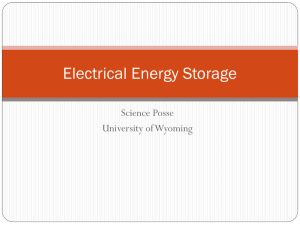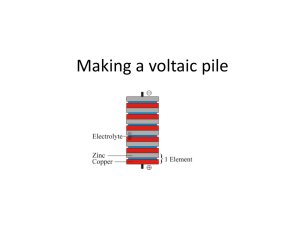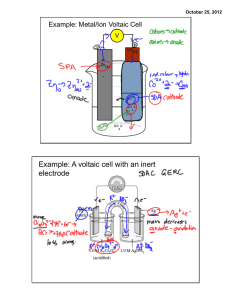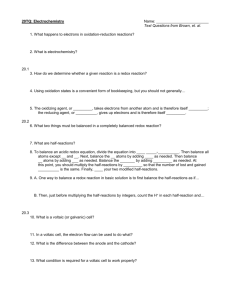Lesson Plan: Electrical Energy Storage
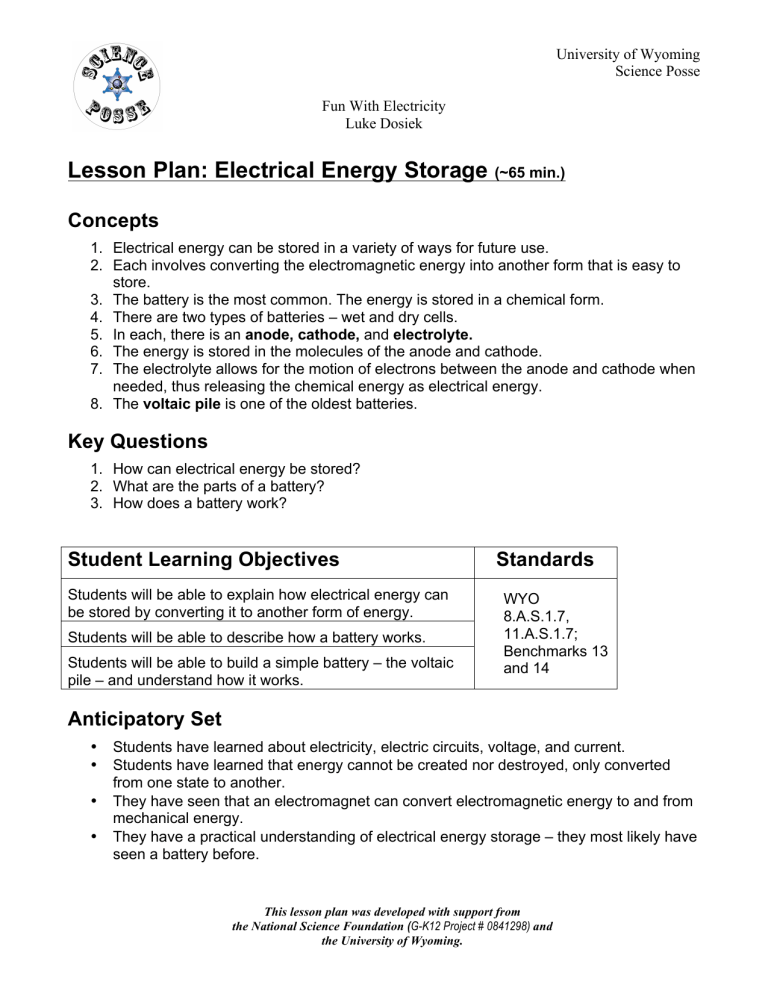
University of Wyoming
Science Posse
Fun With Electricity
Luke Dosiek
Lesson Plan: Electrical Energy Storage
(~65 min.)
Concepts
1. Electrical energy can be stored in a variety of ways for future use.
2. Each involves converting the electromagnetic energy into another form that is easy to store.
3. The battery is the most common. The energy is stored in a chemical form.
4. There are two types of batteries – wet and dry cells.
5. In each, there is an anode, cathode, and electrolyte.
6. The energy is stored in the molecules of the anode and cathode.
7. The electrolyte allows for the motion of electrons between the anode and cathode when needed, thus releasing the chemical energy as electrical energy.
8. The voltaic pile is one of the oldest batteries.
Key Questions
1. How can electrical energy be stored?
2. What are the parts of a battery?
3. How does a battery work?
Student Learning Objectives Standards
Students will be able to explain how electrical energy can be stored by converting it to another form of energy.
Students will be able to describe how a battery works.
WYO
8.A.S.1.7,
11.A.S.1.7;
Benchmarks 13 and 14
Students will be able to build a simple battery – the voltaic pile – and understand how it works.
Anticipatory Set
•
Students have learned about electricity, electric circuits, voltage, and current.
•
Students have learned that energy cannot be created nor destroyed, only converted from one state to another.
• They have seen that an electromagnet can convert electromagnetic energy to and from mechanical energy.
•
They have a practical understanding of electrical energy storage – they most likely have seen a battery before.
This lesson plan was developed with support from the National Science Foundation ( G-K12 Project # 0841298) and the University of Wyoming.
University of Wyoming
Science Posse
Fun With Electricity
Luke Dosiek
Key Terms
Ion
Cathode
Teaching Plan
Battery
Electrolyte
Anode
Voltaic Pile
General Plan o Part 1: Electrical Energy Storage o Part 2: The Voltaic Pile and Activity
The accompanying PowerPoint presentation, Electrical Energy Storage.ppt, closely follows the following teaching plan.
•
Part 1: Electrical Energy Storage o Ask the class how they think electrical energy could be stored. (5 min.) o Most will say battery. Lead them toward other examples such as (10 min.)
§ Battery – uses the electromagnetic properties of the molecules of certain elements and compounds to get electrical energy from chemical energy.
§ Fuel cell – uses electricity to break water into hydrogen and oxygen gases. The gases are stored and when electricity is needed, they are recombined into water.
§ Flywheel – electricity is used to spin an electrical motor connected to a
HEAVY object. Once the object is spinning rapidly, the motor is shut off, allowing the object to spin on its own momentum. When electricity is needed, the spinning flywheel is connected to a generator and electricity is produced. o How does a battery work? (20 min.)
§ The battery is comprised of 3 main parts: the anode, cathode , and electrolyte.
§ The anode is a metal object that has an excess of electrons, giving it a negative charge.
§ The cathode is a metal object that has a shortage of electrons, giving it a positive charge. (To help remember the difference, think of “cats” as being friendly and nice, so they’re a positive thing!)
§ The electrolyte is a substance that is an electrical conductor and full of ions.
§ Ions are individual molecules or atoms that have an unbalanced number of electrons, so they have a positive or negative charge.
Basically they’re little particles running around always trying to steal or give away electrons!
This lesson plan was developed with support from the National Science Foundation ( G-K12 Project # 0841298) and the University of Wyoming.
University of Wyoming
Science Posse
Fun With Electricity
Luke Dosiek
§ Good electrolytes include salt water, lemon juice, vinegar, etc.
§ In the battery, an electrolyte is placed in between the anode and cathode. A chemical reaction occurs where the electrolyte acts to create an unbalance of charge on the anode, cathode, both.
§ For example, there may be too many electrons at the anode, giving it a negative charge, and too few electrons at the cathode, giving it a positive charge.
§ When the battery is connected to an external electric circuit , the circuit provides a path for the electrons to flow from the anode back to the cathode, thus returning the metals to their original balanced state.
This is how a battery is “drained!”
§ For this explanation, use drawings on the board!
§ To charge certain types battery, this process can be reversed.
•
Part 2: The Voltaic Pile and Activity (30 min.) o The Voltaic Pile is one of the first batteries ever invented.
§ 1800 by Alessandro Voltaire. o It consists of several voltaic cells stacked on each other. o A voltaic cell consists of a piece of copper, which acts as the cathode, a piece of zinc, which is the anode, and a piece of paper soaked in an electrolyte. o Pass out the Voltaic Pile handout and briefly discuss the components of this primitive battery. o Mention that a modern battery (AA, etc) has two electrodes with a dry electrolyte. They are a single cell. A “pile” of modern batteries is created when you connect several in series as in a typical battery pack in an electronic device. o Break into groups and perform the voltaic pile activity. o Be sure to reinforce this lesson while the students work.
§ Repeat how the voltaic cells are working as you talk to the individual groups
§ Ask some students to describe to you how they think the voltaic cells are working o In the inquiry starter, the kids will assume that the penny is the source of copper, and is therefore the positive cathode, and that the nickel is the source of zinc, and is therefore the negative anode. o This is wrong! Modern pennies are over 97% Zinc and nickels are 75%
Copper!! Therefore the penny is the anode (-) and the nickel is the cathode
(+) o For the inquiry, some great investigable questions are
§ Which electrolyte works the best?
§ Which combination of coin types works the best?
This lesson plan was developed with support from the National Science Foundation ( G-K12 Project # 0841298) and the University of Wyoming.
University of Wyoming
Science Posse
Fun With Electricity
Luke Dosiek
§ Does increasing the Voltaic cells linearly directly increase the electricity, that is does doubling the number of coins exactly double the electricity produced?
§ Will using pure zinc and pure copper make a difference?
Resources
Electrical Energy Storage.ppt Power Point Presentation
Voltaic Pile Handout
Voltaic Pile Activity and Related Materials.
This lesson plan was developed with support from the National Science Foundation ( G-K12 Project # 0841298) and the University of Wyoming.
University of Wyoming
Science Posse
Fun With Electricity
Luke Dosiek
The Voltaic Pile
•
Invented in 1800 by Alessandro Voltaire.
•
Began as a single voltaic cell: o Two pieces of metal forming the anode and cathode with an electrolyte-soaked piece of paper in between. o He used copper as his cathode and zinc as his anode. The electrolyte was brine.
•
In general, a zinc-copper-electrolyte cell works as follows: o The electrolyte takes reacts with the zinc to break each zinc atom into two electrons, 2e , and one zinc ion, Zn ++ . o The electrolyte itself is broken down into some Hydrogen ions, H + , and some
“other” stuff, depending on the type of electrolyte used. o The zinc ions are drawn off of the surface of the zinc plate and combine with the
“other” stuff in the electrolyte solution, leaving behind all of those electrons. o Before an external circuit is connected, these extra electrons combine with the
Hydrogen ions in the electrolyte to form H
2
molecules at the surface of the zinc plate. o These are visible as bubbles forming on the part of the zinc plate that is submerged in the electrolyte. o This process has a very high electrical resistance. o When an external circuit is connected, it provides a path of very low resistance for the electrons, so they flow out the zinc, through the wire, and into the copper plate, where they combine with the Hydrogen ions in the electrolyte at the surface of the copper plate. o Bubbles are now visible on the part of the copper plate that is submerged in the electrolyte and no longer appear on the zinc side. o As the electrons flow through the external circuit they can be made to do some useful work, like lighting a light bulb.
This lesson plan was developed with support from the National Science Foundation ( G-K12 Project # 0841298) and the University of Wyoming.
University of Wyoming
Science Posse
Fun With Electricity
Luke Dosiek o When the zinc is totally dissolved, or when all of the hydrogen ions in the electrolyte are used up, the battery is “drained.” o The zinc anode has an excess of electrons so it is negative . o The copper cathode is willing to accept those electrons so it is positive.
o Since the two metals now have different charges, an electric potential, or voltage , is created between the two.
• To increase the voltage generated, Voltaire simply piled a whole lot of these cells on top of each other, creating the voltaic pile!
The voltaic cell
The voltaic pile
This lesson plan was developed with support from the National Science Foundation ( G-K12 Project # 0841298) and the University of Wyoming.
Fun With Electricity
Luke Dosiek
University of Wyoming
Science Posse
The voltaic cell before (left) and after (right) an external circuit is connected
This lesson plan was developed with support from the National Science Foundation ( G-K12 Project # 0841298) and the University of Wyoming.
University of Wyoming
Science Posse
Fun With Electricity
Luke Dosiek
3 UnShifted Activity: The Voltaic Pile
Purpose
Often times we need electricity when none can be generated, or more electricity is generated than we need. This mismatch is solved with energy storage devices. One of the simplest and oldest such device is the battery. It stores energy in the form of chemical energy, and then releases the energy as electrical energy when needed. This activity explores one of the earliest battery designs – the voltaic pile.
Materials
•
10 nickels
• 10 pennies
•
A sheet of paper towel
• Aluminum Foil (small strip)
•
Scissors
•
Lemon juice
•
Water
•
Ammeter
Procedure
1. Form groups and gather your materials as instructed by your teacher.
2. Begin by cutting your paper towel into 20 squares, no bigger than a nickel each.
3. Soak 10 of the squares in the lemon juice, and the other 10 in the water.
4. Using the water-soaked paper towels, construct a voltaic stack as shown below.
This lesson plan was developed with support from the National Science Foundation ( G-K12 Project # 0841298) and the University of Wyoming.
Fun With Electricity
Luke Dosiek
University of Wyoming
Science Posse
5. Start by using the aluminum foil as a base. Place your first penny on the foil, making sure some of the foil sticks out. Now place a water-soaked paper towel square on the penny. Next, place a nickel on the paper towel. Keep repeating this until all the coins and water-soaked paper towel are used.
6. Make sure none of the paper towel squares are touching each other!
7. Measure the current produced by the voltaic pile by connecting one wire of the ammeter to the aluminum foil strip and the other to the top coin on your pile.
8. If the needle on the ammeter goes in the wrong direction (left beyond 0), reverse your wire connections on your pile.
9. How many microamps did you measure? ___________________________
10. Now remove half of your voltaic cells so you only have 5 of each coin and 5 paper towel strips.
11. Take an amperage measurement.
12. How many microamps did you measure? ___________________________
13. Now replace all of your water-soaked paper towels with the lemon juice-soaked paper towels.
14. Take an amperage measurement.
15. How many microamps did you measure? ___________________________
This lesson plan was developed with support from the National Science Foundation ( G-K12 Project # 0841298) and the University of Wyoming.
University of Wyoming
Science Posse
Fun With Electricity
Luke Dosiek
16. Now remove half of your voltaic cells so you only have 5 of each coin and 5 paper towel strips.
17. Take an amperage measurement.
18. How many microamps did you measure? ___________________________
Discussion Questions
1. Which electrolyte, the water or the lemon juice, produced more current?
________________________________________________________________
2. Which was the better electrolyte? Why?
______________________________________________________________________
______________________________________________________________________
____________________________________________________
3. What happened to the current when you decreased the number of cells to 5?
________________________________________________________________
If you were to increase the number of cells to 20, what would you expect the current to be (in microamps)?
________________________________________________________________ Lesson
This lesson plan was developed with support from the National Science Foundation ( G-K12 Project # 0841298) and the University of Wyoming.
University of Wyoming
Science Posse
Fun With Electricity
Luke Dosiek
3 Shifted Activity: The Voltaic Pile
Purpose
Often times we need electricity when none can be generated, or more electricity is generated than we need. This mismatch is solved with energy storage devices. One of the simplest and oldest such device is the battery. It stores energy in the form of chemical energy, and then releases the energy as electrical energy when needed. This activity explores one of the earliest battery designs – the voltaic pile.
Materials
•
Change (20 each of pennies, nickels, dimes, and quarters)
•
•
A sheet of paper towel
Medical gauze
•
Aluminum Foil
(small strip)
•
•
•
•
•
Scissors
Vinegar
Water
Lemon Juice
DC Micro
Ammeter
•
•
DC Voltmeter
•
Discs of pure
Zinc
•
Discs of pure
Copper
Directed Experiment
1. Form groups and gather your materials as instructed by your teacher.
2. Begin by cutting your paper towel into 10 squares, no bigger than a nickel each.
3. Soak the squares in vinegar.
4. Construct a voltaic stack as shown below.
5.
6. Start by using the aluminum foil as a base. Place your first penny on the foil, making sure some of the foil sticks out. Now place a vinegar-soaked paper towel square on the penny.
Next, place a nickel on the paper towel. Keep repeating this until all the coins and vinegarsoaked paper towel are used.
7. Make sure none of the paper towel squares are touching each other!
This lesson plan was developed with support from the National Science Foundation ( G-K12 Project # 0841298) and the University of Wyoming.
University of Wyoming
Science Posse
Fun With Electricity
Luke Dosiek
8. Measure the current produced by the voltaic pile by connecting one wire of the ammeter to the aluminum foil strip and the other to the top coin on your pile.
9. Remember the red (+) terminal of your meter should go to the positive terminal of your
Voltaic Stack and the black (-) terminal of your meter should go to the negative terminal of your stack.
10. If the needle on your meter measures negative current, swap your meter’s wire connections around.
11. Is this what you expected based on the class discussion?
12. How many milliamps did you measure?
13. Which coin is acting as the positive terminal, the cathode?
14. Which coin is acting as the negative terminal, the anode?
Raising Questions
Write down as many questions as you can that relate to how you can change something about your battery to affect the way it performs.
For example, “Will doubling the number of coins in the stack increase the current?”
Scientific Inquiry
In the area below (or on a separate sheet) design an experiment to answer one of your questions at a time. Start by rewriting your question. Then design a data sheet to record your results. Finally state in a sentence or two what your conclusions are.
This lesson plan was developed with support from the National Science Foundation ( G-K12 Project # 0841298) and the University of Wyoming.
